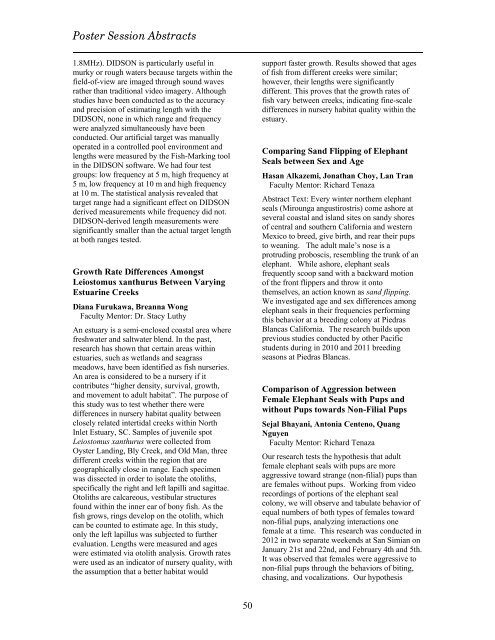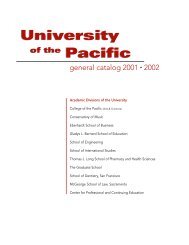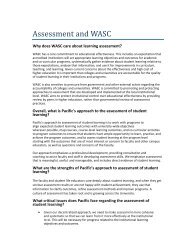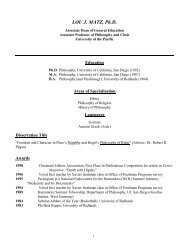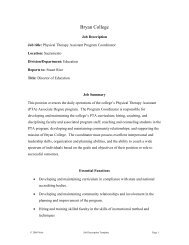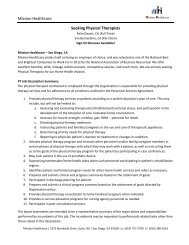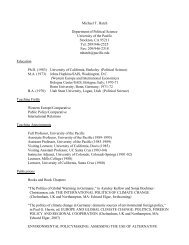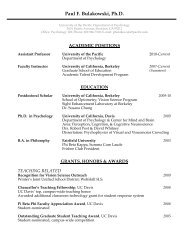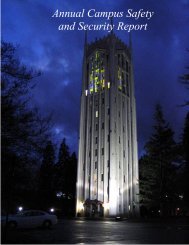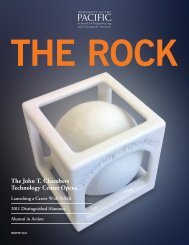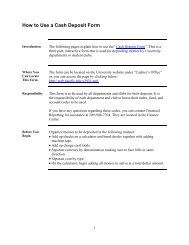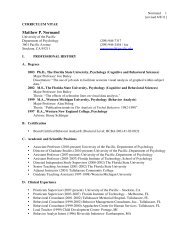purcc 2012 - University of the Pacific
purcc 2012 - University of the Pacific
purcc 2012 - University of the Pacific
You also want an ePaper? Increase the reach of your titles
YUMPU automatically turns print PDFs into web optimized ePapers that Google loves.
Poster Session Abstracts<br />
1.8MHz). DIDSON is particularly useful in<br />
murky or rough waters because targets within <strong>the</strong><br />
field-<strong>of</strong>-view are imaged through sound waves<br />
ra<strong>the</strong>r than traditional video imagery. Although<br />
studies have been conducted as to <strong>the</strong> accuracy<br />
and precision <strong>of</strong> estimating length with <strong>the</strong><br />
DIDSON, none in which range and frequency<br />
were analyzed simultaneously have been<br />
conducted. Our artificial target was manually<br />
operated in a controlled pool environment and<br />
lengths were measured by <strong>the</strong> Fish-Marking tool<br />
in <strong>the</strong> DIDSON s<strong>of</strong>tware. We had four test<br />
groups: low frequency at 5 m, high frequency at<br />
5 m, low frequency at 10 m and high frequency<br />
at 10 m. The statistical analysis revealed that<br />
target range had a significant effect on DIDSON<br />
derived measurements while frequency did not.<br />
DIDSON-derived length measurements were<br />
significantly smaller than <strong>the</strong> actual target length<br />
at both ranges tested.<br />
Growth Rate Differences Amongst<br />
Leiostomus xanthurus Between Varying<br />
Estuarine Creeks<br />
Diana Furukawa, Breanna Wong<br />
Faculty Mentor: Dr. Stacy Luthy<br />
An estuary is a semi-enclosed coastal area where<br />
freshwater and saltwater blend. In <strong>the</strong> past,<br />
research has shown that certain areas within<br />
estuaries, such as wetlands and seagrass<br />
meadows, have been identified as fish nurseries.<br />
An area is considered to be a nursery if it<br />
contributes “higher density, survival, growth,<br />
and movement to adult habitat”. The purpose <strong>of</strong><br />
this study was to test whe<strong>the</strong>r <strong>the</strong>re were<br />
differences in nursery habitat quality between<br />
closely related intertidal creeks within North<br />
Inlet Estuary, SC. Samples <strong>of</strong> juvenile spot<br />
Leiostomus xanthurus were collected from<br />
Oyster Landing, Bly Creek, and Old Man, three<br />
different creeks within <strong>the</strong> region that are<br />
geographically close in range. Each specimen<br />
was dissected in order to isolate <strong>the</strong> otoliths,<br />
specifically <strong>the</strong> right and left lapilli and sagittae.<br />
Otoliths are calcareous, vestibular structures<br />
found within <strong>the</strong> inner ear <strong>of</strong> bony fish. As <strong>the</strong><br />
fish grows, rings develop on <strong>the</strong> otolith, which<br />
can be counted to estimate age. In this study,<br />
only <strong>the</strong> left lapillus was subjected to fur<strong>the</strong>r<br />
evaluation. Lengths were measured and ages<br />
were estimated via otolith analysis. Growth rates<br />
were used as an indicator <strong>of</strong> nursery quality, with<br />
<strong>the</strong> assumption that a better habitat would<br />
support faster growth. Results showed that ages<br />
<strong>of</strong> fish from different creeks were similar;<br />
however, <strong>the</strong>ir lengths were significantly<br />
different. This proves that <strong>the</strong> growth rates <strong>of</strong><br />
fish vary between creeks, indicating fine-scale<br />
differences in nursery habitat quality within <strong>the</strong><br />
estuary.<br />
Comparing Sand Flipping <strong>of</strong> Elephant<br />
Seals between Sex and Age<br />
Hasan Alkazemi, Jonathan Choy, Lan Tran<br />
Faculty Mentor: Richard Tenaza<br />
Abstract Text: Every winter nor<strong>the</strong>rn elephant<br />
seals (Mirounga angustirostris) come ashore at<br />
several coastal and island sites on sandy shores<br />
<strong>of</strong> central and sou<strong>the</strong>rn California and western<br />
Mexico to breed, give birth, and rear <strong>the</strong>ir pups<br />
to weaning. The adult male’s nose is a<br />
protruding proboscis, resembling <strong>the</strong> trunk <strong>of</strong> an<br />
elephant. While ashore, elephant seals<br />
frequently scoop sand with a backward motion<br />
<strong>of</strong> <strong>the</strong> front flippers and throw it onto<br />
<strong>the</strong>mselves, an action known as sand flipping.<br />
We investigated age and sex differences among<br />
elephant seals in <strong>the</strong>ir frequencies performing<br />
this behavior at a breeding colony at Piedras<br />
Blancas California. The research builds upon<br />
previous studies conducted by o<strong>the</strong>r <strong>Pacific</strong><br />
students during in 2010 and 2011 breeding<br />
seasons at Piedras Blancas.<br />
Comparison <strong>of</strong> Aggression between<br />
Female Elephant Seals with Pups and<br />
without Pups towards Non-Filial Pups<br />
Sejal Bhayani, Antonia Centeno, Quang<br />
Nguyen<br />
Faculty Mentor: Richard Tenaza<br />
Our research tests <strong>the</strong> hypo<strong>the</strong>sis that adult<br />
female elephant seals with pups are more<br />
aggressive toward strange (non-filial) pups than<br />
are females without pups. Working from video<br />
recordings <strong>of</strong> portions <strong>of</strong> <strong>the</strong> elephant seal<br />
colony, we will observe and tabulate behavior <strong>of</strong><br />
equal numbers <strong>of</strong> both types <strong>of</strong> females toward<br />
non-filial pups, analyzing interactions one<br />
female at a time. This research was conducted in<br />
<strong>2012</strong> in two separate weekends at San Simian on<br />
January 21st and 22nd, and February 4th and 5th.<br />
It was observed that females were aggressive to<br />
non-filial pups through <strong>the</strong> behaviors <strong>of</strong> biting,<br />
chasing, and vocalizations. Our hypo<strong>the</strong>sis<br />
50


